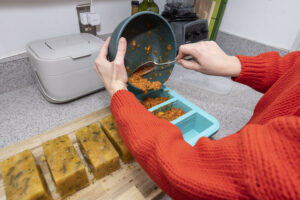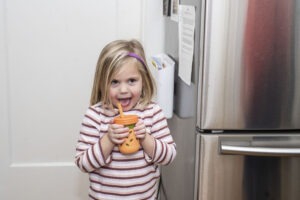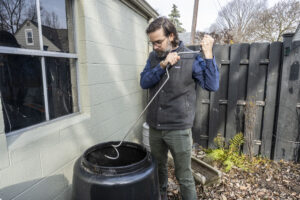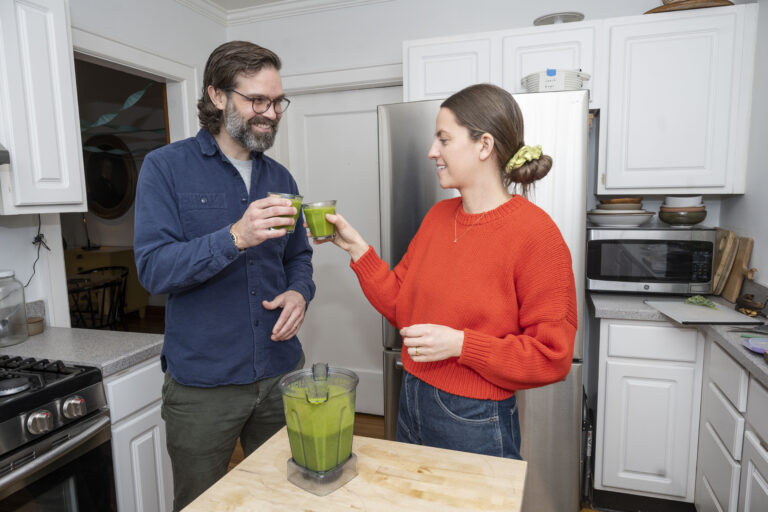Nathan and Laney Ticknor are Columbus residents, who along with their two young children, are passionate about making the most of their food and making compost out of any food that can’t be eaten. They are also recipients of the Community Backyards Program which offers Franklin County residents a discount on a backyard compost bin.
What do you do at home to prevent food waste? 
Laney: We use the freezer a lot, anything that’s gone limp or leftover soup that we’re sick of, we freeze in silicone trays portioned out in 1/2 cup or 1 cup measure. Leftover tomato paste and pesto also get frozen as 2 tablespoon-sized cubes.
We make a lot of smoothies and freeze veggies and fruits for those. When the kids take five bites out of an apple, or if we have limp lettuce or kale, those will go into a smoothie, even celery that isn’t super yummy to cook with.
We love the idea of using every single part of a product. We freeze parmesan rinds and cook them in a spaghetti sauce or soup to elevate the flavor of the food. We now know we can use cilantro stalks, not just the leaves. We also keep a 2-gallon Ziploc bag in the freezer and fill it with vegetable scraps like celery that has gone soft, onion skins and carrot ends. When it’s full, I make stock.
How did you learn these tricks?
Laney: We’ve learned all these tricks over time and often through conversations with friends or family. When we switched to a vegetarian diet I had to think differently about how to cook and eat. When we started to have fresh vegetables around all the time, we were motivated to learn how to make the most of them. Years later, there are still things we are learning. Even now we google how to store things if we don’t know.
Use Save The Food’s Storage Guide & Freezing Guide for beans, nuts, fruits vegetables, dairy, pantry staples, meat and more!
How do others in your household cooperate? 
Laney: It is definitely harder with kids to reduce food waste, especially with little ones. One thing I’ve come to realize is that kids don’t need as big of a portion as we think they do. When I try to expose them to new foods, I’ll give them a bean or two rather than a serving spoonful. Keeping portion size small helps to reduce what gets tossed. Also, using the freezer!
There are times that my son will come home from school and he hasn’t eaten everything in his lunch box. We compost those items, depending on what it is, since it has probably been sitting out all day.
Nathan: There’s always some food that gets composted. That’s okay. We learn as we go. If everyone made an imperfect effort, that’s a lot better than a few making a perfect effort.
Find more tips on How To Waste Less with Kids.
How did you get started composting? 
Nathan: Before moving back to Columbus in 2016 we lived in Portland, Oregon. They have community composting that is collected weekly. They provide the box for under the sink and the barrel that is collected. Before that, neither of us had experience composting but it was so easy, simple and free to learn with the community-wide program. Compost was collected more frequently than trash. When we moved back to Columbus, it was jarring how difficult it was to compost, even though we still desired to. Luckily, a lot of the habits we had formed remained, but the outlet was gone. We still missed composting and we tried paid community programs here, but the cost was prohibitive at the time. When we had the opportunity to get the backyard compost bin through the Community Backyards program it was liberating.
Most weeks we don’t even need to take our trash barrel out for pick-up because it’s so empty. We’ve been able to amend our soil and grow our garden. But, I dream of the day the streets are lined with more organics bins than trash cans.
Apply for a compost rebate through the SWACO-funded Franklin Soil and Water District’s Community Backyards program
Food Waste Prevention Tips:
-
- Use your freezer liberally – using ice cube trays is a great way to freeze liquids.
- Freeze half-eaten and leftover fruits and veggies to make smoothies.
- Save stalks from things like cilantro, and wilted veggies to make broth when you have enough frozen scraps.
- Reduce food portions for your children – you can always give them more.
- Compost uneaten food from your kids’ school lunch leftovers.
- Get started with backyard composting using this backyard composting guide.
Explore SaveMoreThanFood.org/make-a-difference/at-home to find tools and resources to help you reduce food waste.”
